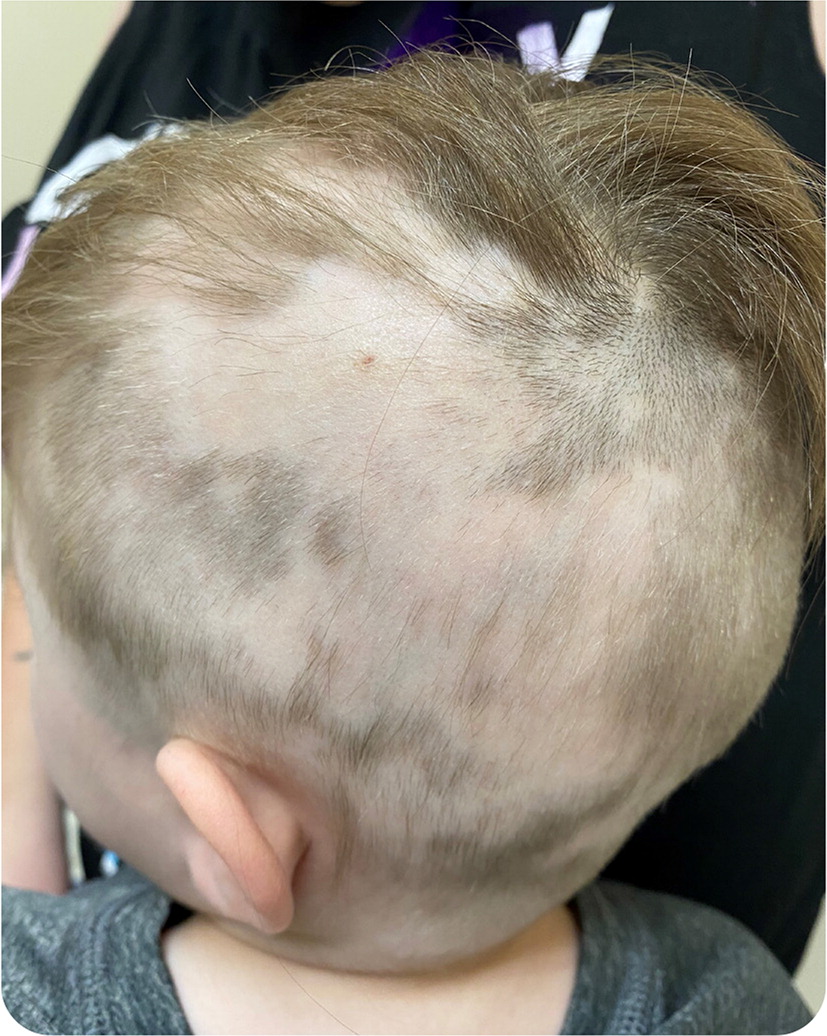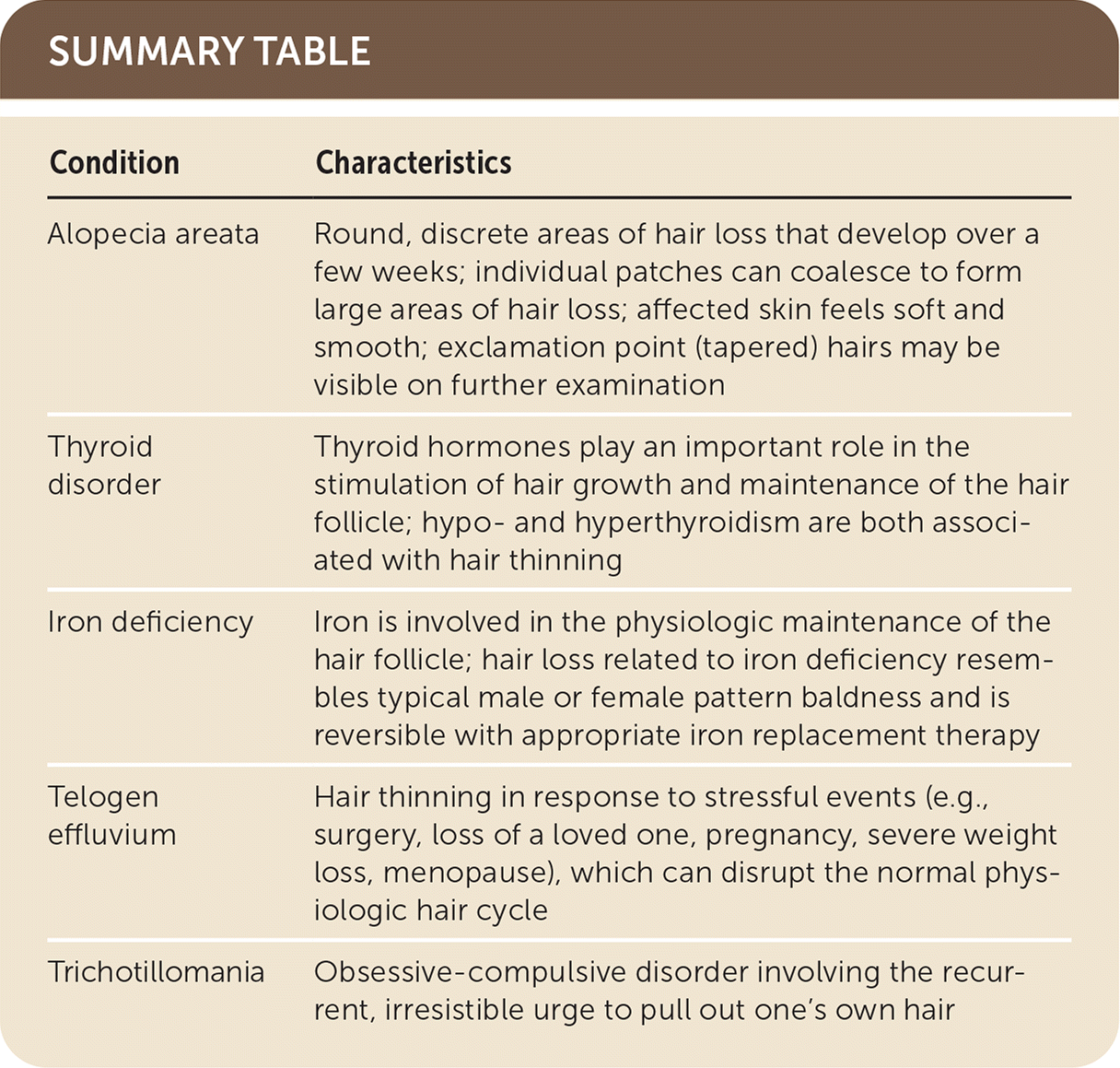
Am Fam Physician. 2022;105(3):317-318
Author disclosure: No relevant financial relationships.
A three-year-old boy presented with hair loss that started as a small patch on the back of his head, then spread to the bilateral temporal and parietal areas over the previous two months. The patient had no other symptoms such as rash, pruritus, or skin discoloration. According to his mother, the patient did not pull his hair out and had no history of scalp trauma. He had no history of skin or hair conditions. His only significant medical history was a leg fracture earlier in the year that did not require surgery or casting and healed without complications.
The child was growing well and was in the 50th percentile for height and weight. He met all developmental milestones. Patchy hair loss was evident in the occipital, temporal, and parietal areas of the scalp (Figure 1). The skin in the affected areas appeared normal and was smooth and nontender to the touch. Dermatoscopy revealed tiny black dots in the affected areas.

Question
Based on the patient’s history and physical examination findings, which one of the following is the most likely diagnosis?
A. Alopecia areata.
B. Hypothyroidism.
C. Iron deficiency anemia.
D. Telogen effluvium.
E. Trichotillomania.
Discussion
The answer is A: alopecia areata. Alopecia areata is a common cause of nonscarring hair loss. It most commonly affects the scalp but can occur anywhere with hair. The condition typically presents as round, discrete areas of hair loss that develop over a few weeks. Individual patches can coalesce to form large areas of hair loss. In the affected areas, the skin feels soft and smooth.1 On close examination, short and broken hairs can be visualized. These are referred to as exclamation point hairs because they are thicker at the apex of the shaft and progressively thin toward the base.2 Common variants of alopecia include ophiasis (band-like hair loss around the temporal and occipital scalp), alopecia totalis (total hair loss on the scalp), and alopecia universalis (loss of all body hair).1
Alopecia areata is often associated with nail abnormalities. Nail pitting is most common, but trachyonychia, Beau lines, onychorrhexis, nail thinning/thickening, onychomadesis, punctate or transverse leukonychia, red spots on lunulae, and koilonychias may also occur.2
The pathophysiology of alopecia areata is not completely understood. Evidence suggests an autoimmune reaction to the hair follicles. Any age group can be affected, and the condition is strongly associated with family history and environmental factors such as stress.2 Alopecia areata is typically a clinical diagnosis based on the lack of skin findings associated with other conditions.1 Findings such as a positive hair pull test or dermatoscopic signs of active disease (yellow dots, black dots, exclamation point or tapering hairs, and broken hairs) can aid in diagnosis. If the diagnosis is uncertain, a biopsy from the borders of the affected areas may be helpful. Biopsies may show increased lymphocytes, decreased anagenic hairs, increased catagenic hairs, or signs of inflammation.2
Alopecia areata has an unpredictable prognosis. Hair often regrows within 12 months, but recurrence is common. Less than 5% of patients progress to alopecia totalis and alopecia universalis, from which full recovery is rare.2 If the area of hair loss is limited, intralesional injections of steroids may be beneficial. Topical corticosteroids are also an option. If the disease is more widespread, treatment options include topical immunotherapy and systemic corticosteroids.1,2 In refractory cases, disease-modifying antirheumatic drugs such as methotrexate or immunosuppressants such as azathioprine (Imuran) can be used. The psychological distress associated with hair loss may also require treatment.2
Thyroid disorders (hypo- and hyperthyroidism) can lead to skin, nail, and hair changes. Hair loss due to thyroid disease is typically related to loss of overall hair volume that may produce small bald patches. Patients typically report hair thinning and have other symptoms of thyroid disorder. The hair loss is reversible with treatment of the underlying disorder.3,4
Hair loss related to iron deficiency is a result of decreased oxygen delivery to hair follicles. It resembles typical male or female pattern baldness and is reversible with appropriate iron replacement therapy.5
Telogen effluvium is hair thinning due to a larger than normal number of hair follicles moving from the anagen to telogen phase. This happens in response to stressful events such as surgery, loss of a loved one, pregnancy, severe weight loss, or menopause.6 The condition resolves spontaneously in six to nine months.
Trichotillomania is an obsessive-compulsive disorder involving a recurrent, irresistible urge to pull out one’s own hair, to the point of noticeable hair loss.7

| Condition | Characteristics |
|---|---|
| Alopecia areata | Round, discrete areas of hair loss that develop over a few weeks; individual patches can coalesce to form large areas of hair loss; affected skin feels soft and smooth; exclamation point (tapered) hairs may be visible on further examination |
| Thyroid disorder | Thyroid hormones play an important role in the stimulation of hair growth and maintenance of the hair follicle; hypo- and hyperthyroidism are both associated with hair thinning |
| Iron deficiency | Iron is involved in the physiologic maintenance of the hair follicle; hair loss related to iron deficiency resembles typical male or female pattern baldness and is reversible with appropriate iron replacement therapy |
| Telogen effluvium | Hair thinning in response to stressful events (e.g., surgery, loss of a loved one, pregnancy, severe weight loss, menopause), which can disrupt the normal physiologic hair cycle |
| Trichotillomania | Obsessive-compulsive disorder involving the recurrent, irresistible urge to pull out one’s own hair |
